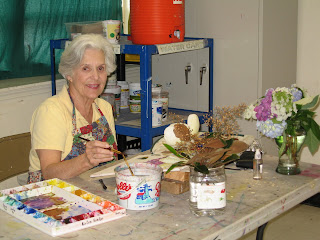The other day I shared what I bring on location for oil painting, today I'll share suggestions for watercolorists:
· Watercolor Paper- Paper quality does make a big difference in watercolor. If there is one place not to cut corners it’s on paper. Some of the cheaper papers just don’t absorb the paint the way the better papers do, so using better paper will give you better results and will be easier to work with. 140lb cold press - Arches brand is preferable. Avoid the inexpensive spiral pads if at all possible. I find the blocks are easiest for painting on location. I suggest taking an Arches block 12 x 16 or 10 x 14 or 9 x 12 ( smaller size is good ,especially if you are a beginner). If you prefer to use loose sheets and have a board to attach them to, then that is fine too. In addition to the block for your paintings, bring along some scrap watercolor paper for exercises and other quick studies we may do.
· Palette – any plastic palette suitable for watercolors (w/cover) [John Pike or Robert Wood are great options]. If you’re just starting out- a simple white plate or inexpensive palette is okay- just make sure it is large enough to give you room to mix paints.
· Paints – Here are some suggested colors (Winsor-Newton, Holbein, Daniel Smith or Sennelier brands preferable, but other brands fine unless noted). Artist’s quality paints will get you much better results than student grade- but either will work. Again these are just suggestions there’s nothing you absolutely have to have. Also, if just starting out, it’s fine to buy the smaller size tubes to keep the cost down. At an absolute minimum you’ll need a red, yellow, blue and burnt sienna, and thalo or winsor green but if you can get a broader range of paints, these are very useful colors to have:
o Lemon Yellow
o New Gamboge or Indian Yellow*
o Cadmium Orange
o Raw Sienna or Yellow Ochre* or Quinacridone Gold
o Burnt Sienna* or Quinacridone Burnt Orange
o Burnt Umber* or Sepia
o Permanent or Quinacridone Red*
o Alizarin Crimson*
o Permanent Rose
o Sap Green*
o Winsor or Thalo Green*(preferable to viridian or hookers green)
o Winsor or Thalo Blue or Prussian Blue
o Cerulean Blue( Grumbacher if possible)
o Ultramarine Blue*
o Cobalt Blue*
o Winsor or Dioxizine Violet
*Indicates suggested minimum palette
Miscellaneous Tools
· plastic container for water
· #2 Pencil, sharpener, eraser
· Sketchbook
· Brushes – round (size 6, 10 or 12), flat (½”, 1”or 2” for washes), rigger
· Natural sponge
· Masking tape ( avoid the blue tape- it can distort color pecreption)
· Tissues/Paper towels
· A cut up credit card
· Anything else you use often in your techniques and can’t be without (we all have our favorite gadgets
General
-Camera (with extra memory discs, battery charger (remember converter/adapter for European currency and other accessories)
-Bug Spray
-Sunscreen
-Bottle to carry water for painting (although you can pick up a bottled water there and re-use that after you finish drinking it)
-A hat
-A small folding stool that you can pack in your suitcase (If you don’t have one, there are some excellent options available thru Judson’s Plein Air 1-866-POCHADE or
http://www.judsonspleinair.com/ ( I have the Roll A Chair- 3133 and really like it- it has good back support and is really lightweight)
-You can bring a lightweight easel if you have one and like to use it. For watercolor, I find a small folding stool and a block that you can put on your lap work pretty well.
Despite all this, try to think minimal and not have too much to carry around- it gets heavy (maybe someday I will follow my own advice). Take a bag you can carry all your supplies in.
In terms of the plane- pack anything that could been viewed as a knife( even palette knives) inside your packed luggage. I pack my paint tubes inside Ziploc bags inside a Tupperware type container in my suitcase and note that they are artists supplies- non-flammable/hazardous in case someone checking my bag isn’t familiar with watercolor paints. If you have some absolute favorite brushes, you may want to take them in your carry on just in case-I do- I’d hate to have to rebuild my collection of brushes if my luggage got lost.
If I've missed any of your favorite on-location tools or supplies, or if you have any other tips, please send a comment to share with others. Thanks and Happy Painting!






























